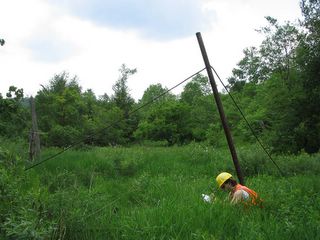
Phantom railroad ties - these are evenly spaced indentations in the ground where ties would have been placed, and track on top. Sometimes the ties were removed when the track was no longer used, and recycled elsewhere on a new track. Occasionally we find sections of rail and ties that are still in the ground. Rails and ties are not present at most historic railroad grades that we record. We look for other clues which indicate a grade may have been present, including tie marks, elevated tramways, borrow pits along the sides, and water crossings. Often topography and an absence of vegetation can be a clue that a grade may be present, though sometimes it's difficult to tell the difference between a grade, a historic road, and a grade that may have been reused as a road.



























